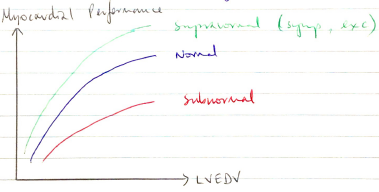G3i: Explain the Frank-Starling mechanism and its relationship to excitation-contraction coupling
Frank-Starling Mechanism
- Sarcomere = the basic unit of striated muscle
- Normal sarcomere length = 1.8µm
- ↑sarcomere length = ↑force generated
- ↑preL/EDV = ↑SV
- This happens up to a point → 2.2µm, where any further ↑sarcomere length = detrimental to force generated

This is an intrinsic property of heart that allows it to rapidly adapt to ∆ volumes of venous return
Excitation-Contraction Coupling
- ECC = an electrical impulse linked to a mechanical response (contraction)
- Mechanism of the ECC:
- AP
- Membrane depol
- L type Ca2+ channel release Ca2+
- Sensed by RYANODINE REC
- Mass Ca2+ release from SR
- Ca2+ binds TnC
- Conformation ∆ Troponin-Tropomyosin complex moves away from Actin
- Myosin head binds to Actin → forms cross-bridge
- ATP hydrolysis powers cross-bridge cycling*
- Shortens sarcomere length (contraction happening)
- Until Ca2+ deplete OR ATP deplete
- SERCA pump on SR (powered by ATP) → causes Ca2+ to return to cell*
- Ca2+ from TnC
- Conform ∆ → Troponin-Tropomyosin inhibition continued
*ATP for both contraction & relaxation
How F – S Causes ↑ECC
- ↑sarcomere length = ↑efficiency of E-C-C (up to a point 2.2µm)
- By:
- ↑overlap of Actin/Myosin = ↑cross-bridging
- ↑sensitivity of myofilaments to Ca2+
- ↑affinity of Tn to Ca2+
- All these allow MAX FoC when E-C-C initiated